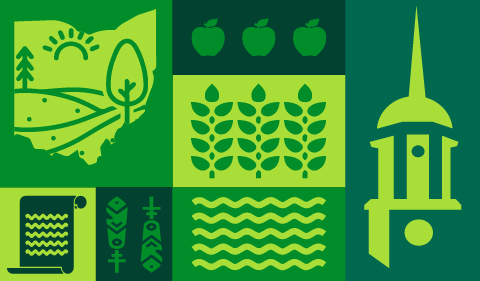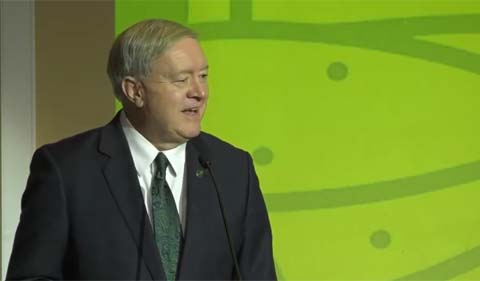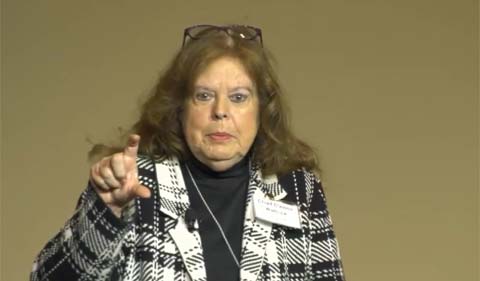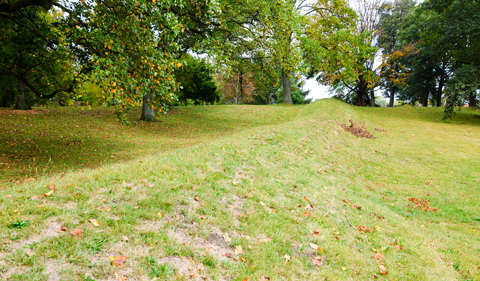The first settlers to Ohio arrived more than 13,000 years ago. They likely traveled a land bridge from Asia down through Western North American, then made their way east to the Ohio Valley.
More modern history finds another group of settlers coming from the newly formed republic in Eastern North America, heading west into the Northwest Territory.
By 1839, about 4 million people had moved into the Northwest Territory in the 50 years since the Northwest Territorial Ordinance of 1787 was written. “This was one of the largest movements of human beings from one region of the planet to another to have occurred up until this time. It’s amazing the Earth didn’t just tip a little bit,” said Dr. Anna-Lisa Cox at the conference on Settling Ohio: First Nations and Beyond, held Feb. 20-21 at Ohio University.
For two days speakers weaved together tales of migration, farming, education, conflict and commerce in what would become the state of Ohio. Their research showed that while David MuCullough’s recent bestseller, The Pioneers: The Heroic Story of the Settlers who Brought the American Ideal West, illuminated how the Northwest Territory began with a settlement at Marietta in what is now Southeastern Ohio, there are many, many stories still to be discovered and told about the land between Lake Erie and the Ohio River.
The two-day conference organized by Dr. Brian Schoen, Associate Professor of History at Ohio University, and Dr. Tim Anderson, Associate Professor of Geography, looked at the many ways Ohio was shaped by its first settlers, including how they built the state’s government, economy, agriculture and homes.
Stories That Need to be Told
“Ohio became a state in 1803, and our university was integral to the growth of the state and the region, and while this conference will focus on the beginnings of Anglo-European settlement, we know that the first people in what is now Ohio arrived more than 13,000 years ago—more than 13,000 years ago,” said Ohio University President Dr. M. Duane Nellis as he introduced the conference.
“And these native peoples overcame a lot of challenges, things like rapid climate change. For those of us who are geographers we know about continental glaciation and some of the things that were happening in this part of what is now North America. And these native peoples built some of the first homes and became the first people to clear land and to produce food on this land.”
He noted that a goal of the conference is to shed light on groups who “have not always received the attention they deserve, and this includes the indigenous populations as well as African Americans and immigrants.”
Some of the World’s First Farmers
Dr. Joseph Gingerich opened the conference with an overview of “Ohio’s First People and the Rise of the First Settled Villages.” These Native Americans settled in Ohio more than 13,000 years ago and adapted to a changing world, first dining on woolly mammoths the size of today’s elephants, and eventually turning to farming and domesticating some of the crops in eastern North America.
“This is one of only nine independent domestication events in the world,” noted Gingerich. Assistant Professor of Anthropology at Ohio University.
He also noted that “around 2,000 years ago these first pioneers built some of the most impressive forms of monumental architecture anywhere in the world.”
A Legacy of World Heritage Scale
Chief Glenna J. Wallace of the Eastern Shawnee Tribe closed out the conference by bringing the audience back to those monuments, known as “mounds” in Ohio vernacular, and a possible legacy for the region’s Native Americans.
Wallace and her tribe aren’t from Ohio anymore. Unlike some other states that created local reservations, Ohio and the federal government forced \ indigenous peoples west to what was known as “Indian lands.”
Wallace said that by the time her ancestors got to Kansas in December of 1832, there were only 69 people left.
Wallace’s own journey included traveling for three years with her family on the West Coast as migrant laborers, then seeing 70 countries in her role as a college professor and administrator. She took students to the world World Heritage Sites—the Great Wall of China, the Acropolis, Stonehenge.
In 2007, a year after she became chief, she came to Ohio State for a lecture series to hear John Sugden, who had written a biography of Tecumseh.
“The next day Ohio State University took John Sugden and anyone who wanted to go to a place called Newark Earthworks. I had no idea what I was going to see,” Wallace said, but “the minute I looked out and saw Newark Earthworks, because of the travels that I had done before, because of the places that I had seen, I recognized immediately — this is a treasure. This is phenomenal. And why are we having golf competitions on top of this? And why cannot the people go and visit this, and see this, and experience this? And why did this happen?” she asked.
“It’s not Shawnees who built that. I’m not saying that. It’s Native Americans…. That’s the legacy–part of the legacy–that I want to leave in Ohio, for all of my ancestors, for all of the tribes that were here.”
Wallace is working with the Ohio History Connection, which has nominated the Newark site for designation as a World Heritage Site.
“There are 1,121 sites in the world. There are only 24 in the United States. Ohio has the opportunity to be the 25th site in the United States,” Wallace said.
- Read the Ohio History Connection World Heritage nomination of Ancient Ohio Earthworks.
- Join Friends of World Heritage Ohio.
John Bickers, an advanced doctoral student at Ohio State University and member of the Miami Nation, gave a talk about how the Miami peoples sought to consolidate tribal identity after the defeat at the Battle of Fallen Timbers in 1794.
Ohio University Geographer Dr. Timothy Anderson used genealogical work to show how diverse groups of individuals, including different white settlers from the East Coast as well as German and African-American immigrants, shaped the cultural landscape as evidenced in the ornamentation on their houses, churches, and tombstones.
And More Untold Stories
In her presentation, Cox pointed out the many stories of successful African Americans who helped shape Ohio.
“The long-held assumption that African Americans in the North and West were primarily urban is an assumption shaped by the great migration of the 20th century. But before that movement, there was a first great migration, the movement of tens of thousands of free African Americans onto the Northwest Territory. Many of them came to the region before there were even cities, and their goal was not just to survive, but to thrive. They bought land from the federal government–some of them even buying hundreds of acres–which turned them into the equivalent of landed gentry,” said Cox.
Dr. Katherine Jellison, Professor and Chair of History at Ohio University, noted Ada Adams and the local work of the Mount Zion Baptist Church Preservation Society in helping to discover and preserve the history of African Americans in the region.
- A River of Hope fund-raiser showing is Friday, Feb. 28, at 7 p.m. at the Athena Cinema.
- Take the mAppAthens Black History of Athens Tour, completed by the Southeast Ohio History Center in anticipation of this conference.























Comments